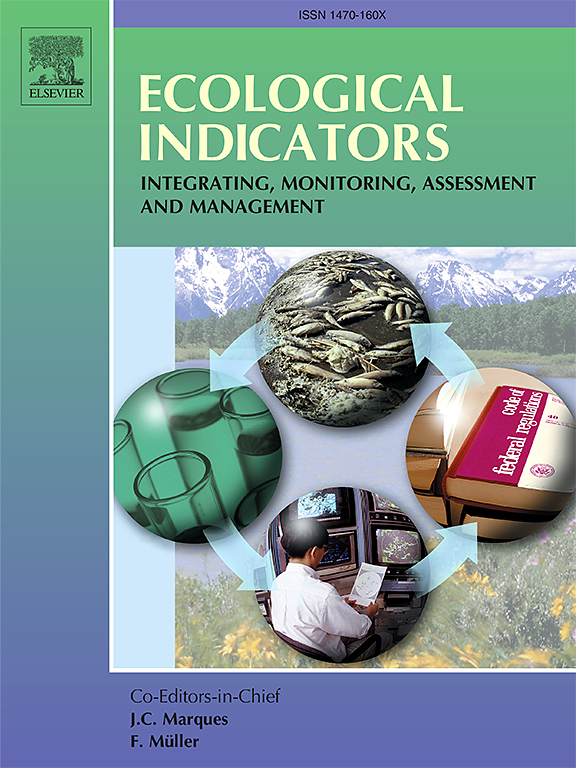Nonlinear threshold effects of environmental drivers on vegetation cover in mountain ecosystems: From constraint mechanisms to adaptive management
IF 7
2区 环境科学与生态学
Q1 ENVIRONMENTAL SCIENCES
引用次数: 0
Abstract
Based on a nonlinear theoretical framework, this study systematically reveals the spatiotemporal evolution characteristics of fractional vegetation cover (FVC) in the Qilian Mountains and its environmental constraints, providing scientific support for mountain ecosystem restoration and territorial spatial management. By integrating remote sensing inversion, GIS spatial analysis, and the constraint line model, the following key findings were obtained: (1) Spatiotemporal Evolution Characteristics: From 2000 to 2023, the FVC in the study area exhibited a fluctuating upward trend (annual growth rate of 0.26 %, R2 = 0.5654, p < 0.001), forming a significant longitudinal gradient pattern. A sharp contrast was observed between the high-coverage areas (FVC > 60 %) in the southeast and the lowcoverage areas in the northwest, where bare land and extremely low to low-coverage regions accounted for 56.25 %. Notably, 54.84 % of the region experienced significant vegetation improvement, with the “greening” effect particularly pronounced in the central and western regions. (2) Topographic Vertical Constraint Mechanism: The altitudinal gradient shaped a four-stage response pattern: in the 2000–2900 m range, vegetation cover increased at a rate of + 1.56 %/100 m, mainly driven by water-heat synergy; in the 2900–4000 m range, accumulated environmental stress reversed the growth trend, leading to a decline of −1.32 %/100 m; in the 4000–4800 m range, thermal constraints intensified sharply, accelerating the decline to −8.01 %/100 m; in the 4800–5800 m range, vegetation approached its survival limit, with the decline rate slowing to −0.57 %/100 m. (3) Climatic Regulation Threshold Effects: Temperature control exhibited a biphasic hump-shaped pattern (R2 = 0.9449). In the −15 °C to −7°C range, the FVC gain rate reached 14.22 %/°C; between −7°C and 0 °C, the gain rate decreased to 3.07 %/°C, with 0 °C identified as a critical threshold. Above 0 °C, increasing competition pressure led to a decline in FVC (−0.68 %/°C). Moisture regulation showed a diminishing marginal effect: in the 20–300 mm range, each additional 10 mm of precipitation increased FVC by 2.97 %; in the 300–450 mm range, the marginal gain decreased to 0.88 %; above 450 mm, moisture constraints were lifted, and light-heat conditions became the primary limiting factors. This study identifies critical ecological thresholds of 4000 m altitude, an annual mean temperature of 0 °C, and 300 mm annual precipitation, elucidating the nonlinear response mechanisms of mountain ecosystems. Furthermore, it establishes a multidimensional “topography-climate-management” adaptive regulation framework, providing a scientific paradigm for transitioning ecological restoration from “maximum greenness” to “optimal resilience.”
环境驱动因素对山地植被覆盖的非线性阈值效应:从约束机制到适应性管理
基于非线性理论框架,系统揭示祁连山植被覆盖度时空演变特征及其环境制约因素,为山地生态系统恢复和国土空间管理提供科学依据。通过遥感反演、GIS空间分析和约束线模型相结合,得到以下主要发现:①时空演化特征:2000 - 2023年,研究区植被覆盖度呈波动上升趋势(年增长率为0.26%,R2 = 0.5654, p <;0.001),形成显著的纵向梯度模式。高覆盖度地区(FVC >;东南低覆盖区占60%,西北低覆盖区占56.25%,其中裸地和极低至低覆盖区占56.25%。值得注意的是,54.84%的区域植被得到了显著改善,其中“绿化”效果在中西部地区尤为明显。(2)地形垂直约束机制:海拔梯度呈现4阶段响应模式:2000 ~ 2900 m区域,植被覆盖度以+ 1.56% /100 m的速率增长,主要受水热协同驱动;在2900 ~ 4000 m范围内,累积环境应力逆转了生长趋势,下降幅度为- 1.32% /100 m;在4000 ~ 4800 m范围内,热约束急剧增强,加速下降至- 8.01% /100 m;在4800 ~ 5800 m范围内,植被接近生存极限,下降速率减缓至- 0.57% /100 m。(3)气候调节阈值效应:温度控制呈双相驼峰型(R2 = 0.9449)。在- 15 ~ - 7°C范围内,FVC的增益率达到14.22% /°C;在- 7°C和0°C之间,增益率下降到3.07% /°C, 0°C被确定为临界阈值。在0°C以上,竞争压力增加导致植被覆盖度下降(- 0.68% /°C)。水分调节表现出边际效应递减,在20 ~ 300 mm范围内,每增加10 mm降水量,植被覆盖度增加2.97%;在300 ~ 450 mm范围内,边际增益降至0.88%;在450mm以上,水分限制解除,光热条件成为主要限制因素。研究确定了海拔4000 m、年平均气温0℃、年降水量300 mm的临界生态阈值,阐明了山地生态系统的非线性响应机制。此外,它建立了一个多维的“地形-气候管理”适应性调节框架,为生态恢复从“最大绿色”过渡到“最佳恢复力”提供了一个科学范式。
本文章由计算机程序翻译,如有差异,请以英文原文为准。
求助全文
约1分钟内获得全文
求助全文
来源期刊

Ecological Indicators
环境科学-环境科学
CiteScore
11.80
自引率
8.70%
发文量
1163
审稿时长
78 days
期刊介绍:
The ultimate aim of Ecological Indicators is to integrate the monitoring and assessment of ecological and environmental indicators with management practices. The journal provides a forum for the discussion of the applied scientific development and review of traditional indicator approaches as well as for theoretical, modelling and quantitative applications such as index development. Research into the following areas will be published.
• All aspects of ecological and environmental indicators and indices.
• New indicators, and new approaches and methods for indicator development, testing and use.
• Development and modelling of indices, e.g. application of indicator suites across multiple scales and resources.
• Analysis and research of resource, system- and scale-specific indicators.
• Methods for integration of social and other valuation metrics for the production of scientifically rigorous and politically-relevant assessments using indicator-based monitoring and assessment programs.
• How research indicators can be transformed into direct application for management purposes.
• Broader assessment objectives and methods, e.g. biodiversity, biological integrity, and sustainability, through the use of indicators.
• Resource-specific indicators such as landscape, agroecosystems, forests, wetlands, etc.
 求助内容:
求助内容: 应助结果提醒方式:
应助结果提醒方式:


